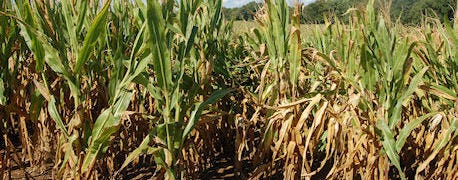
If you have good corn that was only minimally affected by dry weather, stalk rots or rot lodging may not be a major concern in your area. It will be a game changer in the hardest-hit areas. But even where conditions weren't as severe, there is usually some lodging every year in certain fields, either from rootworm damage, poor rooting or stalk rots that come in later in the season.

ROOTS LET GO: This corn is falling over or already fallen over likely due to just poor root development. It was extremely dry and hot when it was growing in this area.
Dave Nanda, director of genetics and technology for Seed Consultants, Inc. and a frequent contributor to Corn Illustrated, believes it's important to know how much lodging is occurring in your fields, and to separate the two types of lodging. Whenever he evaluates plots in the fall just before harvest, he attempts to calculate root lodging, stalk lodging and total lodging on a percentage basis. He typically takes counts in one/one-thousandth of an acre strips at various points within the plot or field.
Knowing the amount of lodging may help you decide when to harvest the field. If the field is already lodged, or if plants don't bounce back when pushed over, either from root or stalk rot problems, then that field should be marked for early harvest.
Tracking the cause of root lodging lets you know if your insect control program is working. Is the hybrid with a genetic trait to prevent rootworm attack working, or is control beginning to fail? If you sprayed an insecticide, how well did it work?
This year in hard-hit drought areas, root lodging may be caused by a simple lack of root mass. Some plants didn't send roots deep enough or develop enough root mass to support the plant later in the season. This is simply because there wasn't enough moisture early to encourage proper root development.
Stalk rots may also be prevalent where corn has been stressed. If there are also ear molds, it's important to identify the mold. An olive-green mold on ears when you pull back the shucks indicates that it is likely Aspergillus. This mold can produce mycotoxins, including aflatoxin, which can be detrimental to livestock and is not desirable in corn headed for the food grade market.
About the Author(s)
You May Also Like




